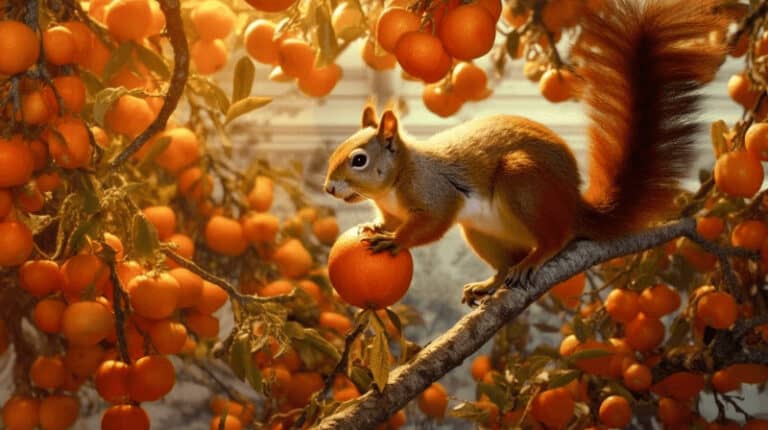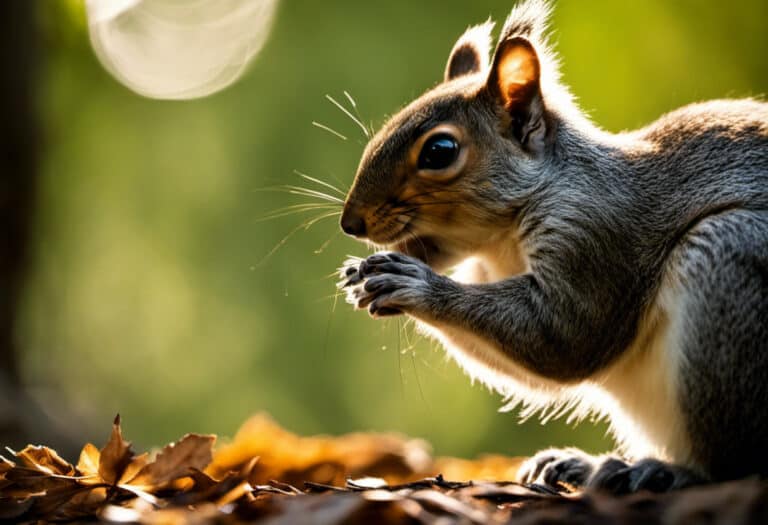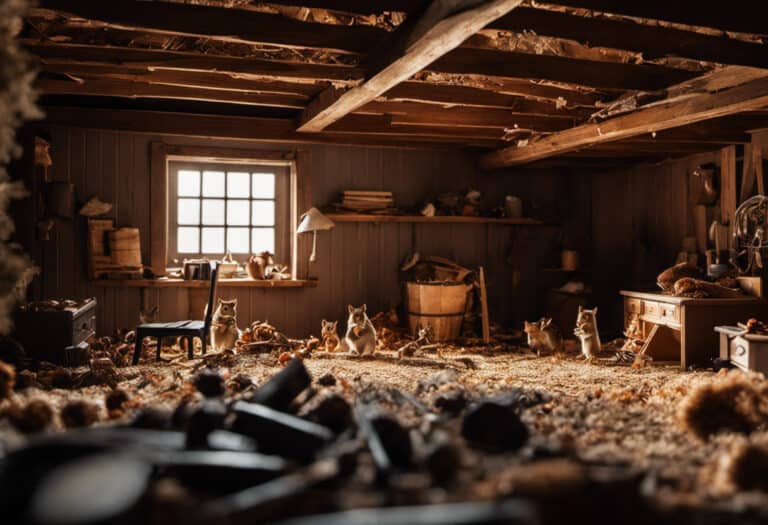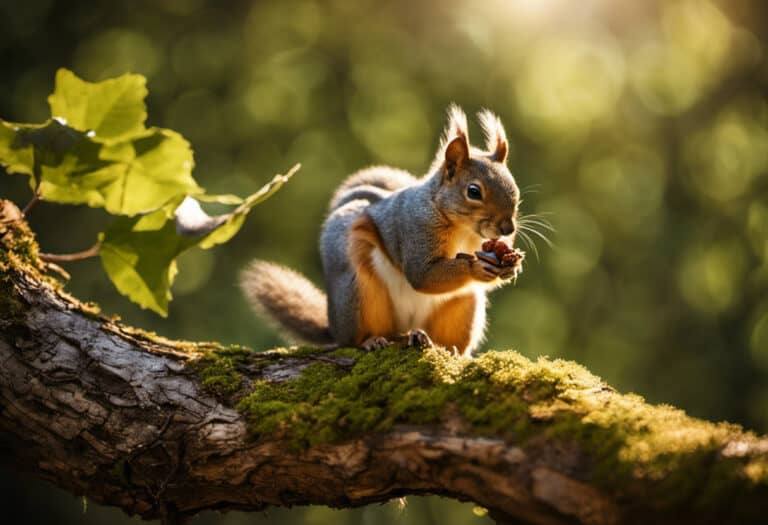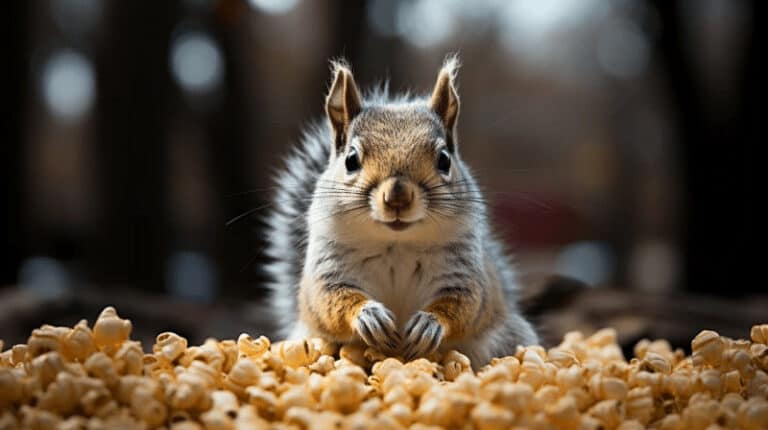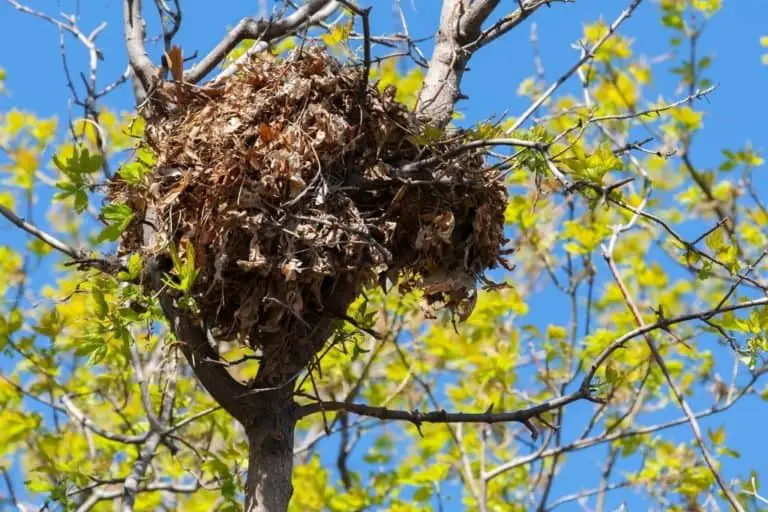Where Do Squirrels Sleep? Unveiling Their Resting Habits!
Ever wondered where squirrels sleep? Do they curl up in little hammocks high in trees or snuggle into underground burrows?
Prepare to be amazed because these fluffy-tailed creatures have some surprising bedtime preferences.
Do they nestle in tiny tree hammocks or hibernate in underground burrows?
Brace yourself for some mind-blowing revelations because these bushy-tailed critters have unexpected sleeping habits.
Where do squirrels sleep?
Squirrels are known for their agility and cleverness, but have you ever wondered where these furry creatures retreat when it’s time for some shut-eye?
Trees: The Popular Choice
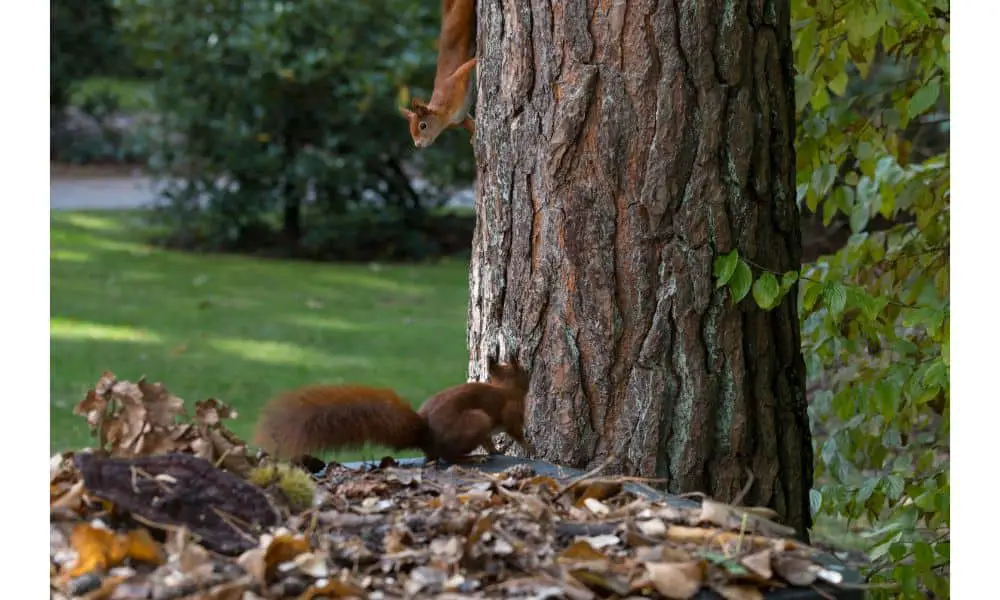
When picturing a squirrel’s sleeping spot, a tree is likely the first image that comes to mind. Tree squirrels, such as gray squirrels, predominantly seek refuge in the branches of trees.
These arboreal creatures have adapted to life among the foliage and have developed a remarkable ability to navigate treetops with ease. Sleeping in trees provides them with several advantages:
- Safety: High above the ground, squirrels are less vulnerable to predators like foxes or domestic cats. Their elevated sleeping spots offer protection from potential threats.
- Camouflage: The leafy canopy is a natural camouflage for these nimble rodents. Their fur blends seamlessly with the surrounding leaves, making it difficult for predators to spot them.
- Easy Access: Being already accustomed to climbing trees throughout their daily activities, it is convenient for tree squirrels to nestle into cozy nooks or build dreys high up in branches.
While many squirrel species favor trees, not all exclusively rely on this arboreal haven.
Ground Squirrels: A Different Approach

Contrary to popular belief, not all squirrels sleep in trees. Ground squirrels choose an entirely different path. These burrowing rodents create elaborate underground caves that serve as both homes and places of rest.
- Hibernation Hideouts: Ground squirrels hibernate during colder months when food becomes scarce. To survive harsh winters, they dig deep burrows where they can safely hibernate until spring arrives.
- Safe and Secure: Female squirrels also seek out underground burrows when giving birth to their young. These underground chambers provide a secure environment for nurturing their offspring away from predators.
- Cool Comfort: Ground squirrels often construct their burrows in areas with cooler temperatures, allowing them to escape the scorching heat during summer months.
How do squirrels sleep?
Tree squirrels sleep in various positions and postures, adapting to their surroundings to rest comfortably and safely.
Understanding how these furry creatures sleep can provide fascinating insights into their behavior and survival strategies.
Different Positions and Postures
Squirrels are known for their ability to sleep in different positions, often perched on tree branches or nestled in cozy nooks.
One common position is the “ball” posture, where they curl up into a tight ball with their tail wrapped around their body.
This helps them conserve body heat during cold nights. Another position is the “flat-out” posture, where they stretch out on a branch or ledge with limbs extended. This allows them to relax while still being alert to potential dangers.
Adapting to Surroundings
Squirrels have impressive adaptability. They build nests called dreys, made of twigs, leaves, and other natural materials high up in trees.
These nests provide insulation against the elements and protection from predators. Squirrels may also seek out tree cavities or hollowed-out trunks as cozy sleeping quarters.
In urban environments, squirrels have learned to adapt using man-made structures such as attics or roof spaces for their nighttime repose.
They may even find shelter within walls or chimneys if access is available. This resourcefulness allows them to thrive even in human-dominated landscapes.
Behaviors for Safety
While squirrels sleep, they exhibit behaviors that help ensure their safety.
One such behavior is “split-sleeping,” where they take short naps throughout the day rather than having one long stretch of uninterrupted sleep at night as humans do.
This enables them to remain vigilant for potential threats while still getting enough rest.
Squirrels have developed an innate instinct called “torpor.” Torpor is a state of decreased physiological activity and lowered body temperature that helps conserve energy during periods of inactivity.
By entering torpor, squirrels can reduce their metabolic rate and survive harsh conditions or food scarcity.
Squirrels’ Eye Behavior During Sleep
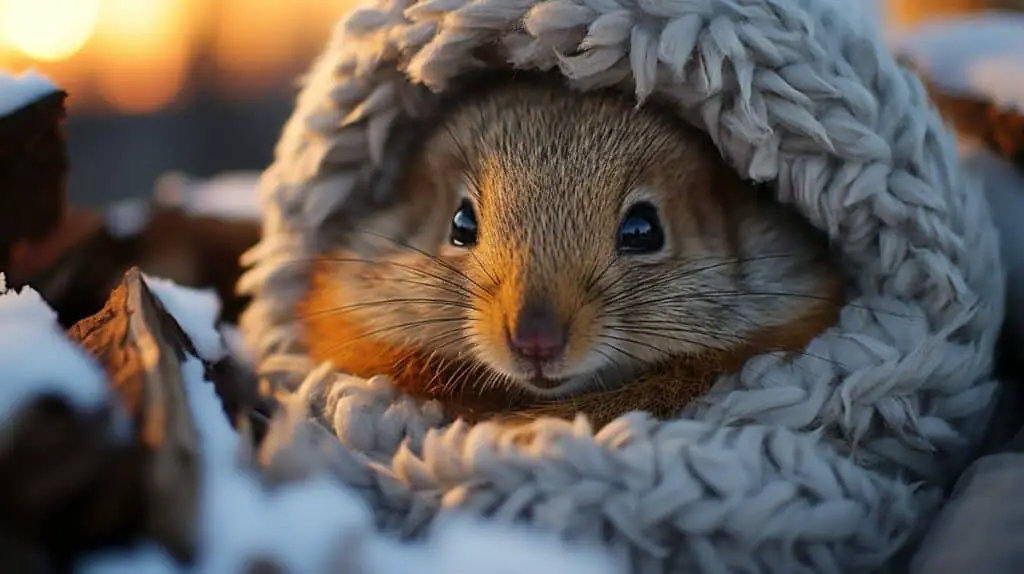
Have you ever wondered what squirrels do when they sleep? Do their eyes close like ours, indicating a deep slumber?
Surprisingly, closed eyes don’t necessarily mean deep sleep for these agile creatures. Squirrels have a fascinating way of using their eyes to stay alert while resting.
Eyes Wide Open
Unlike humans, who tend to shut their eyes completely during sleep, squirrels keep their eyes slightly open.
This unique behavior allows them to remain vigilant and aware of their surroundings, even during naps. Squirrels can quickly detect any potential threats or predators nearby by partially opening their eyes.
The Function of Squirrel Eyelids
Squirrel eyelids serve an essential purpose during sleep. While their upper eyelids are similar to ours, providing protection and moisture for the eye, the lower eyelid sets them apart.
Squirrels possess a translucent nictitating membrane that covers the lower part of their eye while they sleep.
This nictitating membrane is an additional defense against debris and harsh weather conditions. It also allows some light to pass through, enabling squirrels to sense changes in brightness around them.
This remarkable adaptation ensures that squirrels can respond swiftly if danger approaches.
Staying Alert Even When Resting
Squirrels’ ability to stay alert during rest is crucial for survival in the wild. Their keen sense of sight helps them identify potential food sources and avoid predators lurking nearby.
Keeping one eye open while sleeping allows one to easily switch between fully awake and entering a state of rest without missing critical environmental cues.
Imagine taking power naps without losing awareness of your surroundings – that’s precisely what squirrels achieve with their unique eye behavior! This adaptation allows them to conserve energy while remaining on high alert for signs of danger or opportunity.
Sleep patterns and habits of baby squirrels
Baby squirrels have unique sleeping habits
Like human babies, baby squirrels have distinct sleeping patterns that differ from adult squirrels. While adult squirrels are primarily diurnal, meaning they are active during the day and sleep at night, baby squirrels have different approaches to their slumber.
Nest-building is crucial for young squirrels’ sleep
One key aspect of baby squirrel sleep is their reliance on nest-building. Unlike adults who can find shelter in tree hollows or leafy branches, baby squirrels depend heavily on nests constructed by their mothers.
These cozy abodes provide the young ones warmth, protection, and safety during their slumber.
Nests are typically built using twigs, leaves, moss, and fur.
The mother squirrel meticulously weaves these elements to create a soft and secure environment for her offspring. This nest-building process not only ensures a comfortable sleep but also helps shield the young ones from predators.
Mother squirrels cater to their babies’ sleeping needs
Mother squirrels play an essential role in ensuring their babies get adequate rest. They carefully monitor their young ones’ sleeping patterns and adjust accordingly to meet their needs.
For instance, if a baby squirrel is restless or wakes up frequently at night, the mother may alter her behavior to provide comfort or attend to any distress signals.s
To maintain optimal conditions for sleep, mother squirrels regulate factors such as temperature within the nest. They do this by adjusting their body heat while cuddling with the babies or strategically arranging nesting materials to retain warmth.
Mother squirrels synchronize their heart rate with their babies while sleeping together. This bonding mechanism promotes a sense of security and helps regulate the little one’s heart rate and ensure a peaceful slumber.
Winter sleeping habits: Hibernation and nesting
During the cold winter, squirrels employ various strategies to ensure their survival. Let’s delve into two primary techniques they use: hibernation and nesting.
Hibernation: A Winter Survival Mechanism
Hibernation is a remarkable adaptation that allows certain squirrel species to endure harsh winter conditions.
These resourceful mammals lower their body temperature significantly, conserving energy as they enter a deep sleep-like state. By doing so, squirrels can survive for extended periods without searching for food or water.
Squirrels typically seek out secure shelters such as underground caves or cozy nests.
These hideaways provide insulation against the biting cold and protection from predators. Squirrels spend weeks in hibernation, only awakening occasionally during milder weather or when scarce food supplies necessitate short naps outside their dens.
Nests: Essential Winter Sanctuaries
Nesting is another crucial aspect of squirrel survival during the winter months. As temperatures drop and snow blankets the ground, leaf nests become vital shelters for these furry creatures.
Constructed high up in trees using twigs, leaves, and moss, these nests act as warm retreats where squirrels can rest and seek refuge from inclement weather.
Squirrels exhibit impressive nest-building skills by creating intricate structures with multiple layers to enhance insulation.
The outer layer protects against rain and snow, while the inner layers offer warmth by trapping air within the structure. This ingenious design helps maintain a comfortable microclimate inside the nest even when temperatures plummet outside.
Active Adaptations: Defying Winter Slumber
While many squirrel species rely on hibernation or nesting during winter, some have evolved unique adaptations that allow them to remain active throughout the season.
For instance, certain tree-dwelling squirrels possess thicker fur coats that provide enhanced insulation against the cold. These adaptable creatures can brave chilly weather and continue foraging for food, albeit with reduced activity levels.
Squirrels may seek alternative shelter options when nests are unavailable or unsuitable. They may utilize tree cavities, holes in the ground, or even cozy crevices within human-made structures as temporary homes.
Insights into the fascinating world of squirrel sleep
Now that you know where squirrels sleep, how they sleep, and even their eye behavior during sleep, you’ve gained a deeper understanding of these furry creatures.
It’s truly fascinating to uncover baby squirrels’ sleeping patterns and habits and their winter sleeping habits, including hibernation and nesting. Squirrels are remarkable creatures that have adapted unique strategies for survival.
So next time you spot a squirrel scurrying up a tree or leaping from branch to branch, take a moment to appreciate the incredible world of squirrel sleep.
These little acrobats have mastered finding cozy nests and adapting their sleeping patterns to suit different seasons. Keep observing them in your backyard or local park, and who knows what other intriguing behaviors you’ll discover!
FAQs about squirrel sleep:
How long do squirrels sleep?
Squirrels typically sleep for around 14 hours a day. However, this can vary depending on season, age, and food availability.
Do squirrels hibernate?
While some species of squirrels do hibernate during the winter months, not all squirrels engage in this behavior. Ground squirrels are known for hibernating while tree-dwelling squirrels like gray squirrels and fox squirrels remain active throughout the year.
Where do baby squirrels sleep?
Baby squirrels usually stay in their mother’s nest until they are old enough to venture out on their own. The nest provides warmth and protection during the early stages of life.
Can I provide a nesting box for squirrels?
Yes! Consider installing a nesting box high up in a tree to attract squirrels to your yard or garden. This can provide them with an alternative shelter option.
